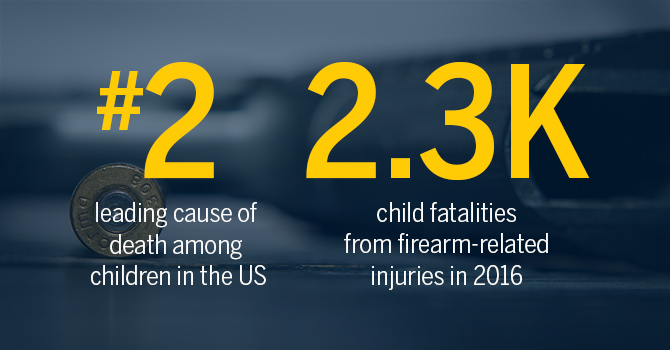Kids and Guns: Safety First

This is the first article of a 3-part series. Read part 2, Kids and Guns: Access to Firearms and part 3, Kids and Guns: Geography, Race, and Policy.
As motor vehicle deaths among children go down, gun deaths are making their way up the ranks and are currently the second leading cause of death among children in the US. In 2016, 2,367 children ages 0 to 18 died of firearm-related injuries, according to WISQARS, the CDC's web-based fatality system. This steady pattern of gun-related deaths goes well beyond the mass shootings that garner media attention and is more concerning to University of Michigan professors Marc Zimmerman, Marshall H. Becker Collegiate Professor of Public Health, and Patrick Carter, assistant professor of Emergency Medicine.
In May, Zimmerman and Carter presented "Kids and Guns: Prevention Strategies," a community conversation in Dexter, Michigan, to help local residents understand the risks associated with youth exposure to firearms and strategies for mitigating those risks.
"Our first goal as public health professionals is to drastically reduce kids dying from firearms regardless of the circumstances. Just as we treat any epidemiological problem of this magnitude with intense research and data-driven interventions, we have to do the same with firearms," said Zimmerman, who is director of the Prevention Research Center of Michigan and the CDC-funded Youth Violence Prevention Center.
Leaders at Saint James Episcopal Church in Dexter worked closely with Zimmerman and Carter. "This goes way beyond politics. We see this as a public health issue, so we looked first to Michigan Public Health," said Janet Cook, a member at Saint James Church and co-director of the congregation's ongoing series on social justice called Coffee & Conversation, which provides an open, hospitable environment for community members of all political views to discuss challenging topics. "None of us want to see Dexter in the news for a gun-related tragedy of any kind, and it's our local community where we can have the most influence," Cook said.
"Our first goal as public health professionals is to drastically reduce kids dying
from firearms regardless of the circumstances. Just as we treat any epidemiological
problem of this magnitude with intense research and data-driven interventions, we
have to do the same with firearms."
—Marc Zimmerman
Zimmerman and Carter explained that public health places the most scrutiny not on hunting or target-shooting weapons but rather on handguns. "Deaths from military-style assault weapons make the news and deserve scrutiny, of course," said Zimmerman. "But firearm deaths from assault weapons account for a small proportion of the total number of firearm-related deaths among children and youth," said Carter. "Most of the children who are injured or killed by a firearm are involved with an unintentional injury from an improperly stored handgun or from a homicide or suicide involving a handgun."
Researchers in public health do look at policy, but since children and youth cannot legally purchase or own guns, researchers look broadly at safety precautions like education and safe storage to address the epidemic. Using key findings from the CDC's Youth Risk Behavior Surveillance System Survey and a range of other studies, Zimmerman and Carter's presentation combined data with narratives from their own experiences working with local communities around Michigan to suggest interventions that could work in Dexter and beyond.
"We really look forward to these opportunities to share our work directly with the communities we serve as University of Michigan researchers," said Zimmerman. "The interaction helps us see how our research affects communities, and it provides immediate feedback on whether we're looking at public health problems in helpful ways and framing interventions in ways that people can put into practice."
This is the first article of a 3-part series. Read part 2, Kids and Guns: Access to Firearms and part 3, Kids and Guns: Geography, Race, and Policy.
